The war in Ukraine continues with no clear winner in site. Last month’s attempted coup in Russia served to intensify both sides’ determination to gain an advantage, whether through pressure on the battlefield or through other, indirect means. For Russia, this translates to cutting off the supply of certain commodities, thereby starving Ukraine of funds and pressuring the West to curtail its miliary and economic support. The latest manifestation of this is Russia’s cancellation of the Black Sea Grain Initiative, the agreement to allow shipments of grain through Ukrainian ports.
After the war erupted in March 2022, Russia imposed a naval blockade on Ukrainian ports. Since Ukraine is a major world producer and exporter of wheat, sunflower oil, and corn, prices for these commodities immediately shot to record or near-record highs. With the aid of Turkey and the UN, both sides agreed to the Black Sea Grain Initiative in July 2022, which enabled ships to freely pass out of Ukrainian ports to their worldwide destinations. In exchange, it was agreed that Rosselkhozbank, the Russian agricultural bank, would be reconnected to the SWIFT system, enabling Russia to more easily export food and fertilizers to world markets, despite restrictions by shipping firms, insurers, and banks from dealing with Russian producers. Although Russia complained frequently that the terms were not being met, the agreement was extended a few times and generally successful, allowing 33.5 mm tons of agricultural product to flow.
On July 17, Russia announced that it was pulling out of the deal. The war is not going well for the country, and it wants to exert maximum pressure on the Ukrainians. The Ukrainians have responded by attempting to export using alternative routes via the Danube and via land routes through Romania and Poland. In the usual tit-for-tat that is one of the hallmarks of war, Russia responded in turn by attacking Black Sea ports and, for the first time, terminals on the Danube. Both sides appear to be engaging in escalatory behavior. The Ukrainians have been enduring attacks on their civilian infrastructure for some time and appear to increasingly believe that they have nothing to lose.
With that as background, what has been the effect on grain futures? As one would expect, Russia’s withdrawal from the agreement immediately led to sharply higher cash and futures prices. Since the grain initiative had been extended a few times, the market was surprised and shocked by its cancellation. Surprise and shock are the perfect recipe for a significant increase in implied volatility, and wheat and corn options did not disappoint. Wheat prices jumped almost 16% and its implied volatility soared 13 points higher to almost 52%, double the volatility levels seen earlier in the year. Corn reacted similarly, rallying 12% with an 11-point jump in implied volatility.
Given the sharp increases in short term prices, as well as possible curtailment of supply, the prospect of food shortages in areas traditionally supplied by Ukrainian grain increased, specifically in the Middle Eastern and Africa. The Russians are looking for leverage to alleviate sanctions, and apparently believe that the prospect of starvation will weaken the West’s resolve. In addition, they are looking to supply Africa themselves, displacing the Ukrainians and gaining market share.
Futures prices and volatilities have moderated after the initial shock. Since then, market participants have had time to coolly assess the situation. From a longer term perspective, last week’s price and volatility increases were significantly smaller than those achieved just after the war began:
As you can see above, prices and volatilities have a ways to go before approaching the 2022 highs. Apparently, the market believes that either a settlement will be reached, eventually, or that additional supply will come from other sources. In any case, if food shortages are imminent, the market is not reflecting them, at least not yet.


